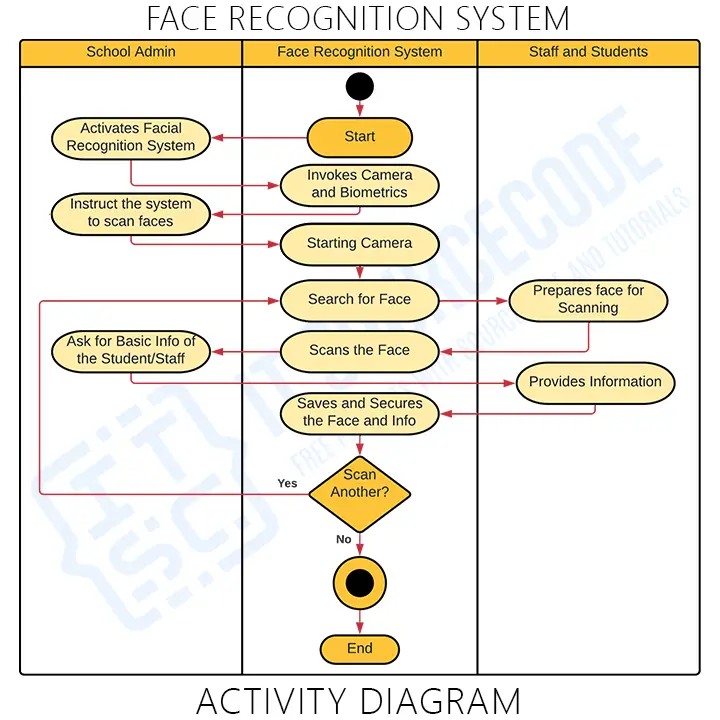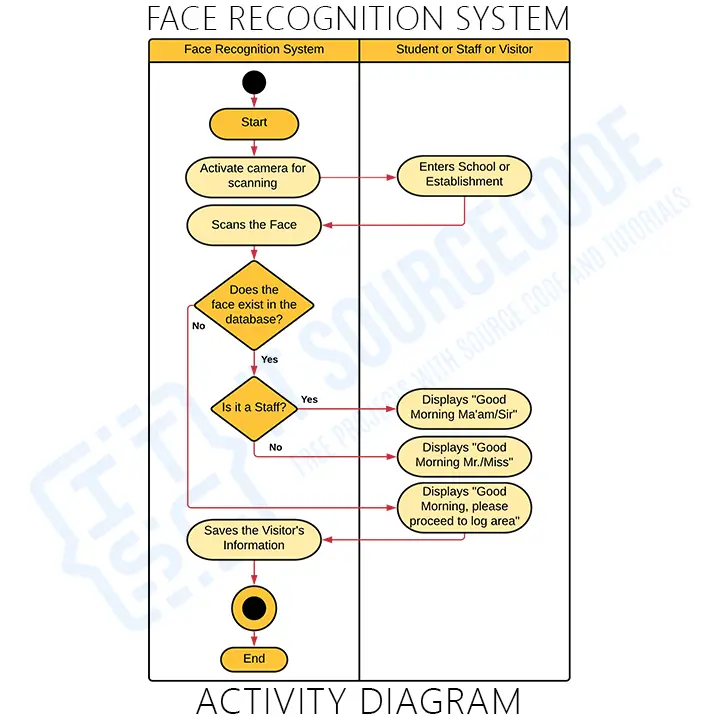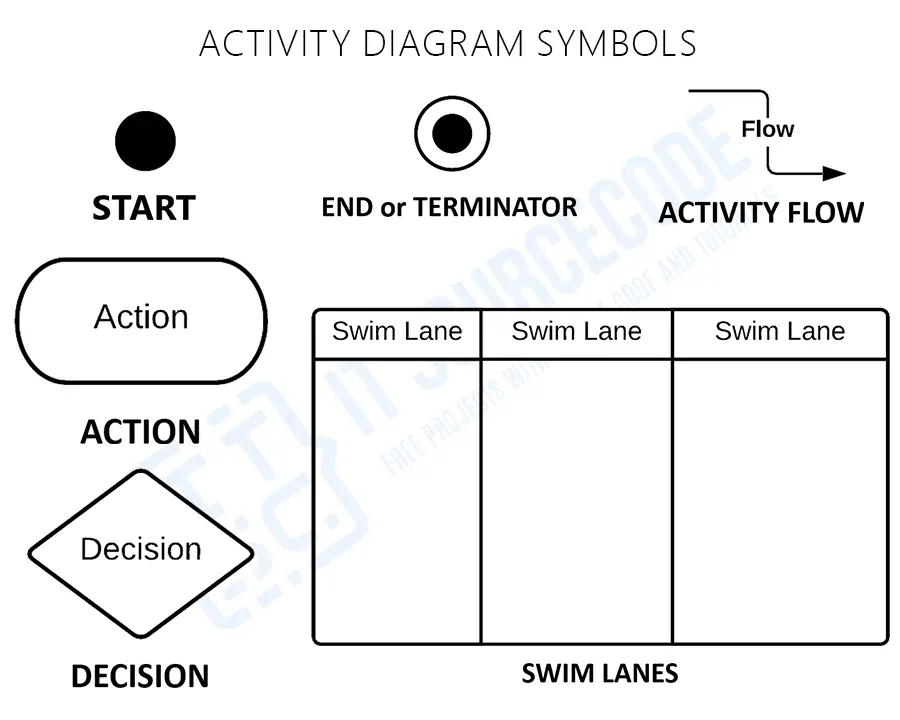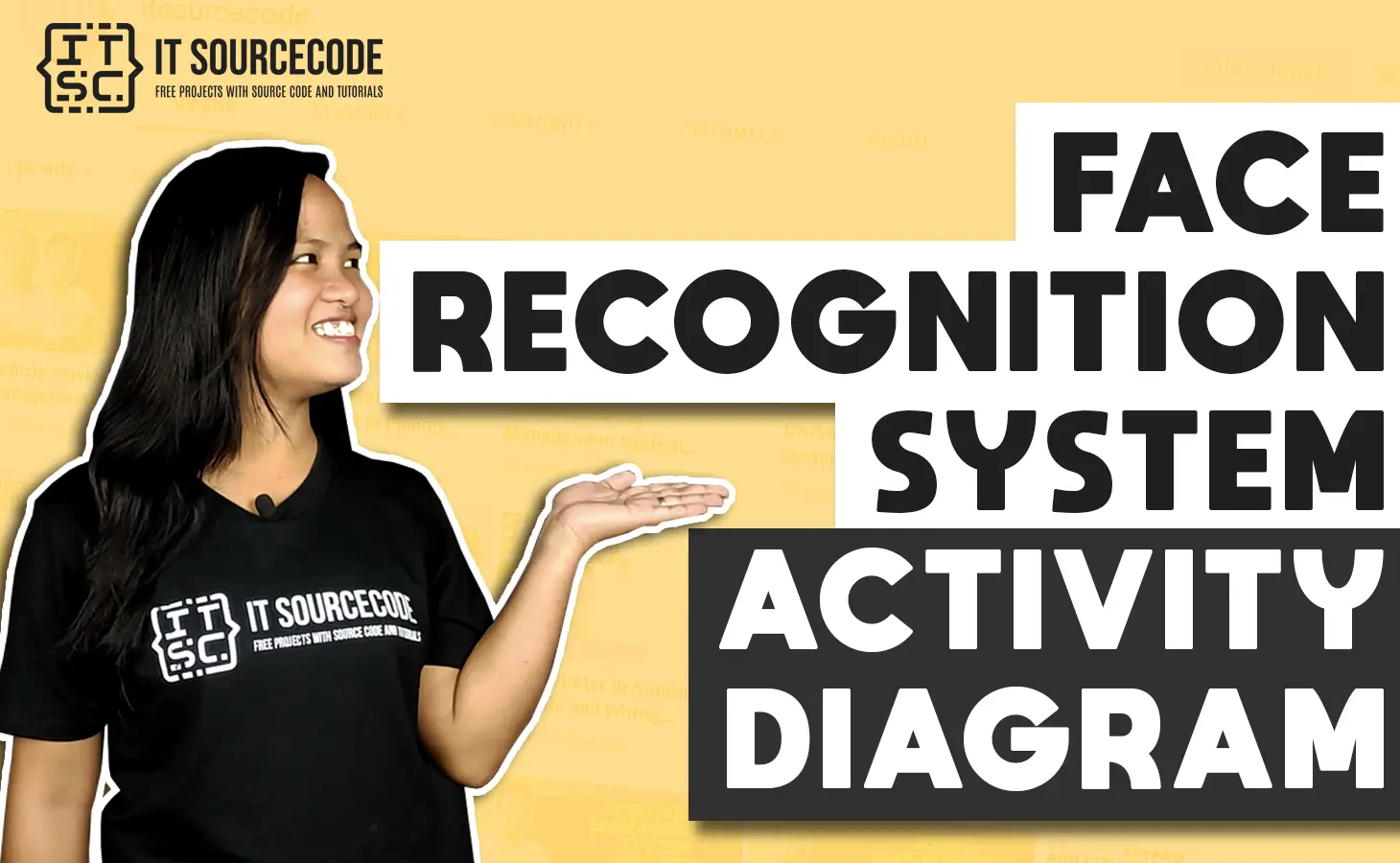The UML activity diagram for face recognition system is a diagram that presents the flow of system activities. It is one of the methods used to document the system behavior in terms of activities and development.
Additionally, the activity diagram uses symbols to define the overall workflow of the face recognition system. It is composed of activities, decisions, and paths (flows).
Face Recognition System Activity Diagram: Project Details
The table shows the overall details of the activity diagram for face recognition system. It discusses the complete information about the project.
| Name: | Face Recognition System Activity Diagram |
| Abstract: | The face recognition system activity diagram represents the behavior of the project in terms of its activities. It contains the important details on the activities and constraints done in the project. |
| UML Diagram: | Activity Diagram |
| Users: | School Admin, Students, Staff, and Visitors. |
| Tools Used: | You may use any Diagram tools that provide activity diagram symbols. |
| Designer: | ITSourceCode.com |
What is a Face Recognition System?
Businesses and other establishments use a face recognition system as a tool for various purposes. Some use this software for checking attendance and others use it for tracking the person who enters and exits the establishment.
The Government also utilizes a face recognition system to trace faces known for illegal activities. Therefore, the software is very helpful for every user and in every way.
Furthermore, the system works with the use of a camera to capture faces through images, videos, or in real-time. The recognized faces were then stored in a database and were used in matching faces for attendances or tracking.
Define Face Recognition System Activity Diagram
UML defines a face recognition system activity diagram as a very effective behavior diagram. This diagram shows the flow of interaction between the system and clients. This is done by helping them visualize the system’s functionality in various degrees of detail.
The activity diagram in UML visually depicts a set of actions or control flows of a face recognition system. It describes the processes in a use case diagram. Its’ illustration can also be sequential or concurrent.
Additionally, the activity diagram can clarify difficult use cases (use case diagram) to simplify and improve any process. It models the system’s actions, functions, and processes.
Importance of UML Activity Diagram
The use of an activity diagram involves major activities that define the workflow of the project. These activities flow with user decisions that result in more effective interaction. It also visualizes a set of actions or control flows of the face recognition system.
An activity diagram in UML represents the Face Recognition System‘s major activities and constraints. Then these activities generate a flow that the project should include. Each activity was labeled properly to determine the system’s behavior.
The activity diagram is one of the Face Recognition System UML diagrams. It also shows the system’s dynamic behavior. It shows the flow of messages from one activity to another.
Activity Diagram: Benefits
The Activity Diagram Benefits are as follows:
- An Activity Diagram helps in understanding how an algorithm works.
- It also describes the steps that a UML use case takes.
- Shows how users and the system interact in a process or workflow.
- Clarify difficult use cases to simplify and improve any process.
Face Recognition System Activity Diagram
The Face Recognition System Activity Diagram example expounds on the system’s ideas. These activity diagram examples using swimlanes are shown in the detailed illustration to enlighten the programmers.
Each of the examples figures out the activities that happen when a user invokes the system. The illustrations below show the activities and scenarios done in the system. Thus, the actions and decisions included were all emphasized here.
Face Recognition System Activity Diagram (Admin, Staff, and Students)
The diagram shown is an illustration of the interaction between the system and the known users. Known users include the students, staff, and admin.

The diagram shows the series of activities and decisions when saving new information from the admin, students, and staff. An admin will activate the system to register new faces and save them into the database. This is to keep the basic information needed for various activities and future use.
This diagram can also be applied to other establishments. The activities included were also applicable for other scenarios and can be modified to meet the other requirements. You can download this diagram and use it for your project.
Face Recognition System Activity Diagram (Students, Staff, and Visitors)
Another example illustration shows the interaction between the software and other users. The other users are meant for students, staff, and visitors. System output varies with the kind of user. To learn its concept, see the explanation below.

The designed diagram portrays the scenario when a student, visitor, or staff enters the school. The camera will scan their faces and validate if they exist in the database.
As soon as the face is determined, the system will confirm if the face is either a student or staff. If the face is none of the two, the system will automatically conclude that the person is a visitor.
If the scanned face is a visitor, the system then will require the visitor’s information and the purpose of the transaction.
You can add more to this and it is up to you how will you create your activity diagram. But, make sure that you have precise information and include the important decisions (actions).
Face Recognition System Activity Diagram Pdf
You may download the Activity Diagram PDF by clicking the button below. It has the full details and discussion on System’s Activity Diagram. You can also modify its content to complete your project requirements and needs.
What are the Symbols used in Activity Diagram?
Activity Diagram Symbols – are used not just to draw an activity diagram, but also to emphasize the role of all that was included in the system’s process. Each of the symbols was used to present a certain part of the system.

- Start – is the beginning of the action. It uses a filled circle symbol to show its function.
- Action – is a stage of an activity in which users or software accomplish a certain task. Action is shown in Round-edged rectangles.
- Decision – symbolizes a conditional branch in the flow. It has two or more outputs and a single input. A diamond symbol presents this notation.
- Swim Lanes – are the lanes showing the actor’s boundaries. The activities drew in the same lane considered as the organization’s activities. Swim lanes must be in a logical arrangement.
- Activity Flow – is another name for the connectors in the diagram that illustrate the flow between processes (activity).
- End (Terminator) – is the last phase of the activity. An indicated black circle represents the final node.
Each of these activity diagram symbols shows the overall system behavior. Emphasizing the system’s behavior would also be much easier by using these Activity Diagram symbols.
How to Draw an Activity Diagram?
Time needed: 5 minutes
Here are the steps in developing (designing) the activity diagram for face recognition system.
- Step 1: Familiarize Activity Diagram Symbols
To draw an activity diagram, you need to familiarize yourself first with the symbols used. The symbols let you discuss the system’s flow of activities and interaction. Programmers can also quickly deliver the system’s concept to the users.
- Step 2: Identify the flow of actions.
After familiarizing the symbols used, you will need to identify the flow of actions. The flow of actions would be based on your use case diagram.
Actions describe the sequence or series of activities when a user invokes the face recognition system. Moreover, the action represents a discrete unit of functionality in an activity diagram. It also describes the steps in a UML use case diagram.
The incoming and outgoing activity edges of actions specify the control flow of data. Its actions begin when all of the input requirements are met. - Step 3: Add the Actors (users) involved.
Actors carry out their actions on things, transforming them into other objects or changing their state. This actor is someone or something that interacts with the system from outside the system.
We use “actors” as labels on the swimlanes to indicate that the action or step performed was from them or the system. This way will help readers and developers how will the system behave or interact with actors or vice versa. - Step 4: Trace the flow of activities.
To trace the flow of activities, make sure that you know that flows can be sequential, branching, or run.
Developers use action or control flows to know the transition from one state of activity to another. There might be several entering and outgoing action flows in this notation.
Furthermore, control flow determines the activity’s flow, and the inbound arrow initiates a single activity step. Upon accomplishing this phase, the flow continues along the outgoing arrow. Object flow also describes the flow of objects (data) within activities.
Conclusion:
In conclusion, we have discussed What is an Activity Diagram for Face Recognition System and the steps on how to develop it. This activity diagram acts as one of the methodologies for creating a face recognition system.
Additionally, an activity diagram stresses the system’s flow of activities and the interactions between the users and the system.
Therefore, using an activity diagram in UML will not only let you understand the project but also tell you the possibilities while designing it. This diagram works best with the other UML Diagrams which are provided in the Recommended Articles. See also other Activity Diagrams in the Related Articles below.
Related Articles:
- ER Diagram for Face Recognition Attendance System
- Component Diagram for Face Recognition System
- Sequence Diagram for Face Recognition Attendance System
- Face Recognition Attendance System Class Diagram
Inquiries
If you have inquiries or suggestions about Activity Diagram for Face Recognition System, just leave us your comments below. We would be glad to hear to concerns and suggestions and be part of your learning.
Keep us updated and Good day!

